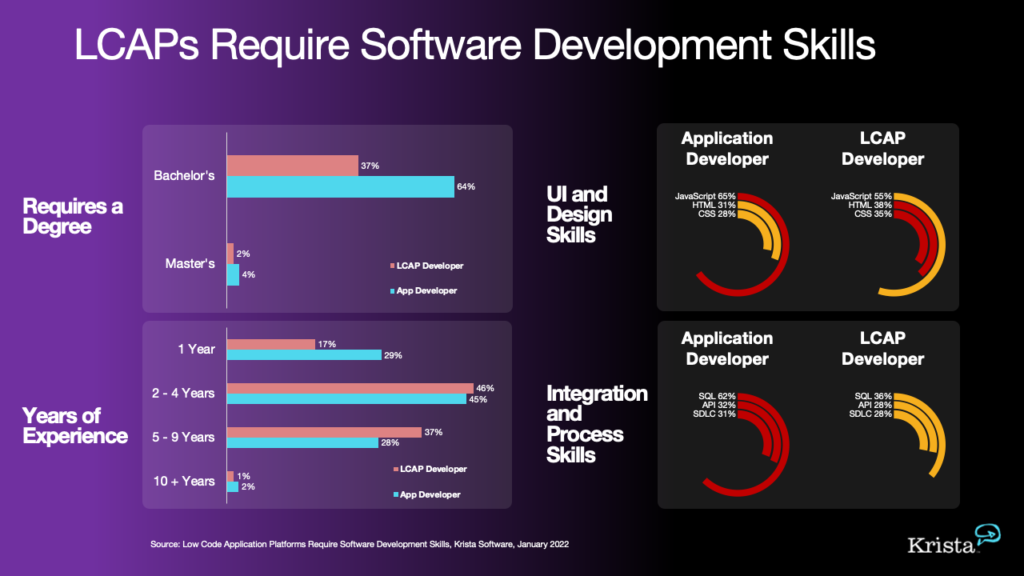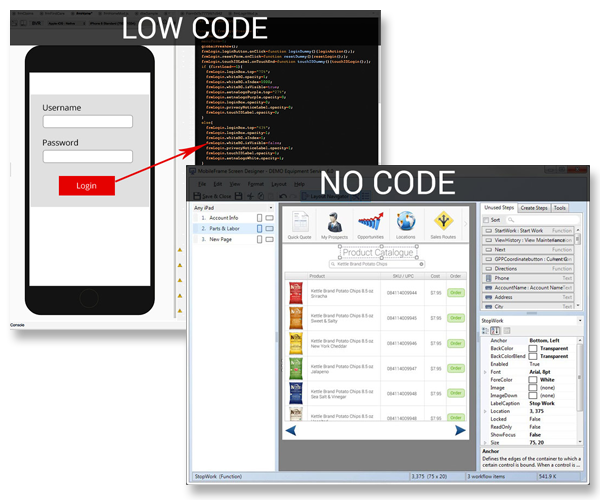Top Info For Selecting Low-Code Platform Sites
Top Info For Selecting Low-Code Platform Sites
Blog Article
The Benefits Of Low-Code Development For Non-Developers In Terms Accessibility
App development that is low-code improves accessibility by non-developers (often called "citizen-developers") due to several key elements.
Drag-and -Drop Builders. Low-code platforms include drag-and-drop interfaces. This gives non-programmers the possibility of building applications in a visual manner, without writing code. This makes development more accessible for people who have no or little technical knowledge.
WYSIWYG editor: "What you see is what you get" editors allow users to create interfaces, workflows and other features in a manner that closely mimics the final result. They are easy to understand and to utilize.
Simple Workflow and Logic Design
Visual Workflow Modeling: Users can create business processes and application logic using visual flowcharts and models, which are more intuitive than traditional coding methods.
Pre-built Logic Components: Low-code platforms typically contain pre-built logic components (e.g. statements that are conditional loops) which can be easily set up, reducing the requirement for complicated coding.
Templates and components that can be reused:
Templates for libraries of pre-built templates Numerous low-code platforms have an application library that can be used for the most common kinds of software, giving non-developers to have a foundation to build upon and then alter.
Reusable modules and widgets: The creation of a website is simplified by using reusable components and modules. This eliminates the necessity for a deep technical understanding.
Guided Development and Tutorials
Step-by-Step guide: Platforms provide tutorials and online assistance to non-developers who are building applications.
Interactive Tutorials Interactive tutorials and hands-on ones let users learn by doing. They gain confidence by making use of the platform.
Integration of existing tools:
Easy integration: Low-code platforms have been created to be able to seamlessly integrate with existing tools and systems for business (e.g. CRM, ERP) allowing non-developers create applications that fit into their workflows.
APIs Connectors: APIs are built into apps to facilitate integration. This allows non-developers, who do not have coding abilities, to connect to external services.
Collaboration Features:
Team Collaboration - Features such as real-time team collaboration, and shared workspaces enable non-developers to collaborate with analysts, professionals, developers, and stakeholders.
Access levels can be set for those who are not developers in order to ensure that they are able contribute to development, without jeopardizing security.
Automated Testing & Debugging
Built-in Testing Tools: Platforms that are low-code often have built-in testing tools and debugging tools to automate these procedures, making it much easier for non-developers and users to ensure that their applications work correctly.
Error Highlighting: When issues arise, the platform highlights them and suggests solutions. It also guides users through troubleshooting.
Overall, the main advantage of low code application development for accessibility to non-developers comes from its ability democratize the process of development. With its intuitive, visually-focused tools and guided experiences, low-code platforms enable business users to participate actively in developing and maintaining apps, thus bridging the gap between business requirements and technical implementation. See the top Low-code Platform for application development for blog examples including ms azure sql, stored sql procedures, cross platform app dev, azure sql databases, stored sql procedures, no code platforms, develop web app, microsoft azure sql, push notifications android, develop web app and more.
Scalability And Flexibility Are The Two Major Benefits Of Low Code Application Development
Low-code development of applications offers a variety of advantages when it comes to the ability to scale and flexibility. These are crucial for building applications that are able to expand with the needs of businesses and be able to adapt to the changing demands. These are the major advantages: Rapid Scaling
Cloud-Based Platforms: A large number of platforms that are low-code-friendly are cloud-based. They permit applications to easily scale up and down with the cloud infrastructure. This allows businesses to manage increasing loads without worrying over the management of servers.
Auto-Scaling Features - Built-in auto scaling capabilities automatically alter resources according to the demand. This ensures continuous performance, even in peak times without the need for manual intervention.
Flexible Architecture:
Low-code platforms facilitate modular design where components can independently developed, evaluated and scaled. This modularity allows for greater flexibility and allows to modify or expand specific areas of the application without affecting other parts.
Microservices Integration Support for microservices architecture allows applications to be constructed by combining loosely coupled services, enhancing both flexibility and scalability.
Customizable Solution:
Extensibility Low-code platforms usually allow for custom-written code and scripting. This lets developers extend applications' functionality beyond what comes out of the box. Developers can meet their specific business requirements without any limitations.
Third-Party Integrations: The ability of businesses to integrate APIs and third-party apps and add new functionalities to the application when needed, enhances its capabilities.
Agile Development & Deployment
Continuous Deployment and Delivery Low-code platforms are able to support agile processes, allowing continuous deployment and integration (CI/CD). This allows for the rapid deployment and update of features.
Iterative Development: The nature of low-code development ensures that applications can be incrementally improved and scaled, reducing the risk associated with large-scale changes and permitting more controlled growth.
Resource Optimization
Low-code platforms provide tools to monitor and manage application performance and help to optimize the use of resources. This helps ensure that resources are utilized efficiently and are easily scaled according to the needs of the user.
Load-balancing: The program is able to handle large volumes of traffic efficiently and with a high degree of consistency thanks to the integrated load-balancing capabilities.
Global Reach
Multi-Region: Low-code platform deployments are typically available across multiple regions which allows businesses to offer low latency access to all users. This is especially important when applications have a large global user base.
Support for Localization Built-in support for localization allows applications to be easily tailored for various languages and needs in diverse markets.
Maintenance and Updates
Simple maintenance: The visual and module design of low-code software makes it easy to perform the maintenance tasks. They allow updates and bugs corrections to be carried out quickly without extensive downtime.
Version Control: Integrated version control systems help manage changes and rollbacks making sure that updates can be released in a safe manner and older versions can be restored if required.
Cost Efficiency:
Reduced Development Costs: Low-code platforms allow for a reduction in the development cost, by removing the need to code in depth. This lets applications be scalable without an increase in costs or development time.
Pay-As.-You-Go: Many lowcode platforms have flexible pricing models, such as pay-as.-you-go. They align costs with actual use and growth, allowing financial flexibility.
Overall, the scalability and flexibility benefits of low-code development allow businesses to create robust, flexible and scalable apps efficiently. These platforms allow for rapid adjustments to meet changing requirements and efficient use of resources and continual improvement, making sure that applications develop and grow to meet the needs of the business. View the top Enterprise application development with Low-code Platform url for site tips including developing mobile apps, cross platform app dev, mobile app development platforms, microsoft azure sql, rad application development, rapid application design, app dev platform, driver jdbc, develop web app, azure sql server and more.
Benefits Of Low-Code Application Development In Terms Of Community Support And Vendor Support
Low-code development platforms have significant advantages when it comes to support from vendors and the community. These are important for successful implementations, ongoing maintenance, and constant development. Support for Vendors
Comprehensive Technical Support:
Support Team with Dedicated Staff: Many low-code platforms have a dedicated support staff who can assist with technical issues or troubleshooting issues, as well as providing assistance. They can ensure that problems are solved quickly.
Certain vendors offer support 24 hours a day. This can be very beneficial for businesses who operate across time zones.
Training and Onboarding:
Training programs that are structured: Vendors offer structured training courses, such as webinars and certification courses. This allows users to quickly grasp the platform.
Personalized onboarding: Many vendors have tailored services for new customers helping them to set up the platform properly and to adapt it to their needs.
Updates and regular updates:
Continuous Improvements: Low-code providers frequently release updates, which include performance enhancements, new features, and security patches to keep the platform up-to-date.
Feedback Integration Vendors integrate user feedback into the development process to ensure that the platform is updated to adapt to changing requirements.
Comprehensive Documentation:
Comprehensive Documentation: A comprehensive and well-organized documentation is usually available that covers everything from basic usage to advanced customization. This allows users to solve problems on their own.
API References: API documentation is detailed and assists developers in integrating APIs with other platforms, and to further modify their applications.
Professional and Consulting Services
Expert Consultation. Vendors provide a variety of consulting services, including the design of architecture along with strategic planning and platform implementations. These services ensure users are able to maximize the benefits of their platform.
Custom Development Services Some vendors offer custom development services in order to build specific functions and integrations that aren't available in the standard.
Community Support
Active User Community:
Forums and Discussion boards A number of low-code platforms have active online communities for users to exchange ideas, ask questions and collaborate.
Meetups and User Groups: Local or virtual user groups and meetings provide opportunities to network, learn and sharing your experiences.
Collaboration and Knowledge Sharing:
Community-Contributed Resources: Users often share templates, modules, and extensions that they have developed, which can be reused or adapted by others, accelerating development and innovation.
Crowdsourced Solution Finding: The collective wisdom and experience of a group could be a great resource for solving difficult problems.
Learning and Development:
Community-led Training: Many groups organize workshops, training sessions, and webinars. They are typically run by knowledgeable users who provide practical advice and the most advanced methods.
Online Tutorials and Courses Community members often create and share online courses, tutorials and how-to guides, improving the learning resources accessible to all users.
Feedback and Influence
Product Feedback Channels Community forums contain a number of channels for giving feedback to vendors. This can influence the design of new features.
Beta Testing Programs. Members of the community that are active be part of beta-testing programmes. They will get early access to the latest features on the platform as well as an have the opportunity to influence the future of the platform.
Recognition and support
Community Recognition Programs: Many vendors have recognition programs to recognize the contribution of the active members of their communities and include MVP (Most Valuable Professionals) programs.
Peer Support: Members of the community typically provide peer support, sharing their expertise and offering guidance for users who aren't as experienced creating a more collaborative and a supportive atmosphere.
Overall, a robust vendor's support and a vibrant, active community provides a complete assistance system for low-code application development. Users will be able get the help, resources, and collaboration opportunities they need to successfully build applications, deploy, keep them up to date and further enhance their apps.